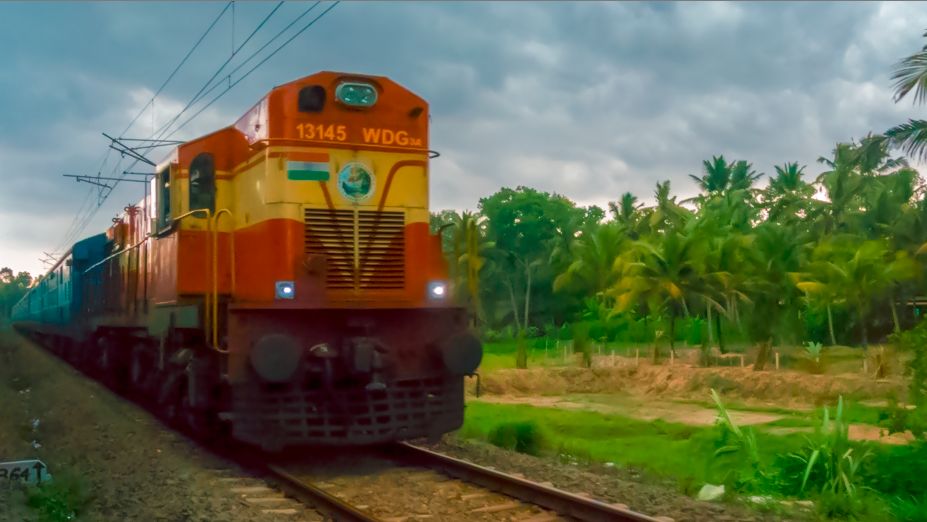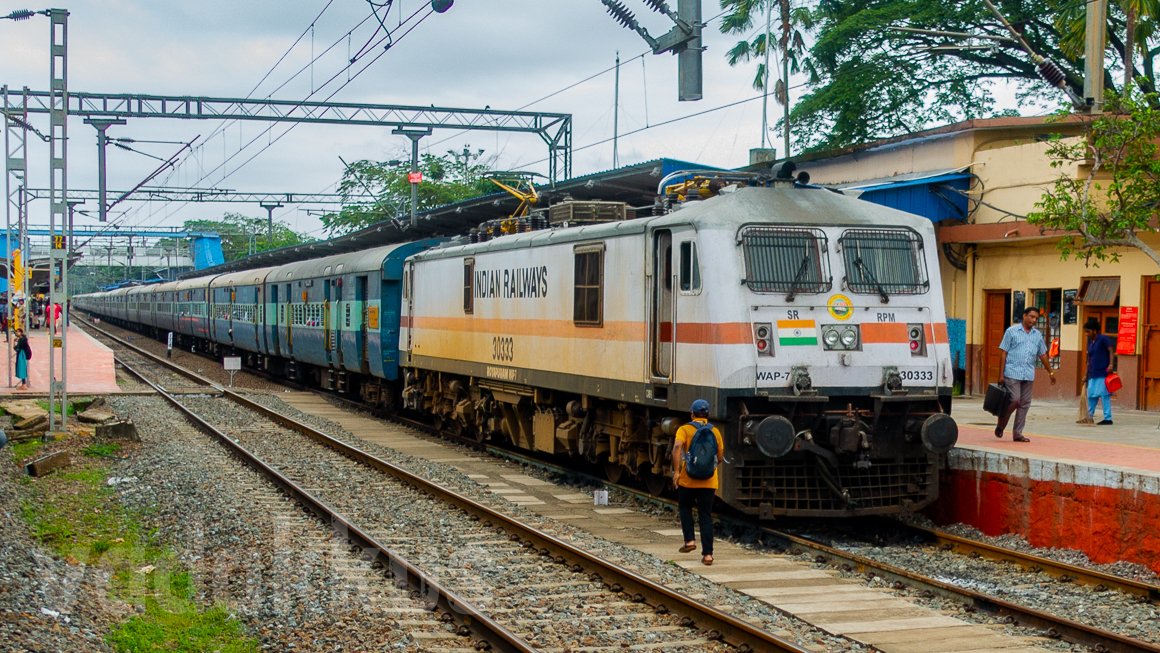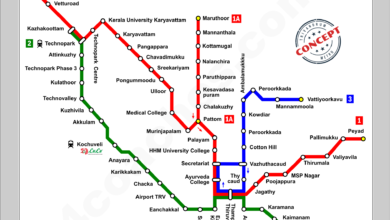Kerala has the Worst Railway Infrastructure in India

In the past few years, the Indian Railways has really improved in the way it operates and services passengers. These changes are actually visible in many aspects of its business, from track to speed to rolling stock to traction to infrastructure to customer service. Brand new LHB trains run at 130 kph, line creation, and track doubling and renewal happen at breakneck speed and officials respond to passenger grievances immediately. However, one state and its people at the south-western corner of the country still lie ostracized. These outcasts get nothing from any plan or project meant to improve the transportation sector in the country. There is no Mission Raftaar here, no new train products, no decongestion initiatives, no nothing. They get the worst coaches, the weakest tracks and the least mindshare among the railways in the country and score the lowest on all indices from punctuality to track health and speed and customer satisfaction with trains that run slower than buses. All while the lucky people of its neighbouring states enjoy much better railway operations, development and networks.
How the Neighbouring States Beat Kerala at Railway Infrastructure
Now, there will be a lot of disagreement on this, especially by brethren from neighbouring states who argue that Kerala has still better rail facilities than their own states. This is only a false perception stemming from the observer’s cognitive biases and an impressional residue because of a few inflated examples from a time when this might’ve been true. For instance, many from western Tamil Nadu base this perception on the one-off incident of the 12677/8 Bangalore-Coimbatore Intercity being extended to Ernakulam. This incident was given great publicity and hence is taken as an absolute example for the “railway favouring Kerala” spin. The extension of one train hardly warrants that. It is another thing that reverse instances like the Amrita Express being extended to Madurai from Palakkad and a number of trains rerouted through Coimbatore hardly find any mention. While the extension of 12677 did not affect CBE passengers in any way, the others did. What people still do not seem to realise is that these high-voltage publicity stunts like train extensions and old trains painted in new colours are not “development”. Real development means infrastructure creation on the ground like new railway lines and terminals, capacity enhancement through doubling and tripling, expansion of stations, modernisation of signalling and so on. All this will automatically enable the running of new trains, which is only the end result, which is where all its neighbouring states actually beat Kerala by a wide margin. Take a look at this chart.
| State | Rail Density / Population | Route KM added last 10 years | Total Track KM added last 5 years | Trains Started last 3 years | Suburban Railway |
|---|---|---|---|---|---|
| Kerala | 0.000061 | -5 | 30 | 3 | No |
| Tamil Nadu | 0.000089 | 144 | 218 | 7 | Yes |
| Karnataka | 0.000084 | 299 | 318 | 11 | Yes |
| Telangana | 0.000087 | 118* | 271 | 10 | Yes |
| Andhra | 0.000104 | 118* | 271 | 9 | Planned |
To start with, Kerala has the lowest per capita railway lines or least rail density per population not just among its neighbours but among all large states in India! This is technically the most basic reason for the infrastructural problems the state faces. The length of the rails it has is simply not enough for this heavily populated land strip. There is a limit to the number of people a railway line and network can carry. Over the last decade, the total railway track length in the state has actually decreased while it got only 3 new trains. All parameters of the other states at the same time grew by leaps and bounds. Tamil Nadu for instance, has seen all of its trunk lines doubled and electrified and its old meter gauge lines (except one) converted to broad gauge. It also got a slew of new trains, especially MEMU and DEMU commuter trains and most of its intercity trains upgraded to LHB rakes. Most of its trunk lines will soon be upgraded to 130 and 160 kph speeds (MAS-CBE). Karnataka is also seeing a massive upgrade in its railway infrastructure in the form of massive construction projects in the form of new lines and doubling of existing tracks and creation of new terminals. Added to this is electrification, Bangalore’s suburban railway, etc. The Bangalore-Chennai corridor will be upgraded to 160 kph, for instance and India’s first “Uday” Express will soon connect Bangalore with Coimbatore. Both states have numerous railway projects of all kinds and hues and many more under construction and progress, all the results of projects initiated during the last decade. If people in TN or KA still think that Kerala has good railways, they should come visiting and travel in our trains of decaying coaches that take one hour to crawl 30 km. Forget the extension of one puny train and open your eyes to the facilities you really enjoy.
The Absolute, Total Neglect Towards Kerala
Simply put, over the past ten years or so, Kerala had been completely neglected by the railway establishment at every level and part of its infrastructure be it construction, tracks, technology, stations, coaches and so on. Here is a comparison study (note, this is not to deny anyone anything or to stroke passions, but just to compare how lucky other people are compared to those in Kerala).
- The 112-km Ernakulam-Kottayam-Kayamkulam line track doubling started in 2001. Today, after 17 whole years, there is still 32 km left to be completed. During less than the same time, 500 km of doubling was completed and commissioned in Tamil Nadu (Chennai-Madurai). In Karnataka, a massive 1300 route kilometres track (Konkan Railway, Chikjajur-Hubli-Londa-Miraj, Hubli-Hospet, Gadag-Hotgi) is currently being doubled. This is equivalent to the entire railway network length in Kerala.
- Karnataka had 300 km of new railway constructed in the past 10 years (Mangalore-Hassan-Nelamangala, Chikjajur-Bellary, Chikmagalur-Nelamangala). There is 500 km more of line under active construction in the state. Kerala saw exactly ZERO kilometres created in the past 23 years. Nothing is under construction, even the Sabari rail. Southern Railway is least interested in taking up new railway lines for construction.
- Bangalore will soon get its suburban railway system worth Rs.16000 crores. Kerala’s pleas for a similar rapid rail transit system costing only a fraction at Rs.3000 has repeatedly been denied.
- Chennai division of the Southern Railway has almost its entire route length under automatic signalling. However, despite Thiruvananthapuram and Palakkad divisions seeing higher traffic density than the Chennai mainlines the railways refuse to install install automatic signalling systems there.
- The 78-km Kollam-Chenkotta gauge conversion project took 14 years to complete. A 100 years ago, the Britishers had built this line from nothing in just 3 years. In the same time, the entire Meter Gauge network in Tamil Nadu was converted to Broad Gauge.
- Trains in Kerala get stinking, decaying 20-plus-years-old rust bucket coaches that break apart while running. Thiruvananthapuram division has just one LHB train and Palakkad has none, while almost all daily intercities in TN and most trains in north India, including random specials, run on brand new LHB rakes.
- Kerala has no Shatabdi, no Double Decker, no Uday, no Tejas, no Humsafar running through the state. The Gandhidham-Tirunelveli Humsafar, announced, in the railway budget has not started running yet even when random Humsafar expresses are being announced to run every other week.
- The rail coach factory at Palakkad which was announced in 2008 has never seen the light of the day even after required land was acquired. In the meantime, three other coach factories were built across the country.
- The Nemom terminal (Trivandrum) announced in 2008 is still sleeping on paper. They refuse to add one new track at available platform space at Thiruvananthapuram Kochuveli terminus. They oppose developing existing stations and (hundreds of acres of) land at Ernakulam and Shoranur into terminals. And then claim there is no space to start new trains. Meanwhile, the Tambaram terminal in Chennai that was announced in 2011 is already operational. Hyderabad just got three new terminals and Bangalore and Mysore one each. Palakkad division does not even have a terminal in its own state.
- Thiruvananthapuram division had been crying for years to be allocated just one additional MEMU rake so six passenger services can be made daily. No avail. There are no MEMU services in the entire Malabar region (Palakkad division) despite the track being fully electrified. Southern Railway has at the same time no problem starting empty DEMUs and MEMUs in Salem and Trichy divisions without anyone even asking for them.
- The state was allowed only three new trains in the past three years even after begging on its knees. At the same time, multiple overnighters now run from from every major city and town in Tamil Nadu and Karnataka to their state capitals, including the Bangalore-Coimbatore Uday Double Decker.
- Both Southern and South Western Railways are holding out stubbornly from starting the 2013 budget announced 22657/8 Trivandrum-Bangalore Premium despite enormous protests. Profit-making trains like the Ernakulam-Rameshwaram special were cancelled citing “lack of patronage” when it ran full for every service. Other requests like a daily service to Howrah, Hyderabad, Ernakulam-Salem, a Shatabdi etc. have never materialised.
- For a state capital and divisional HQ, Trivandrum Central has a grand total of five platforms and one sad excuse of a satellite terminal which has just two platforms. Sure, let us not compare Trivandrum to Bangalore and Chennai. But even Nagercoil has five platforms. As do random small stations like Karur and Mayiladuthurai.
- Railway stations are no better than garbage dumps. Trains are cancelled for want of loco pilots. Tracks not renewed or replaced for the past 15 years. No special trains. No automatic signalling. No suburban railway. No big-ticket projects, No electric loco shed. Accidents galore. And on and on, and on.
And let us not even talk about speed. The best indicator of the health of a railway network is the speeds at which trains run as only strong, well-engineered tracks can sustain high-speed train operations. Indian Railways have taken up renewal and strengthening of tracks to support 130-160 kph as its biggest priority and policy in recent years. As a result most Rajdhani, Shatabdi and Duronto trains now boast of average speeds of 70+ kph with three of them hitting average speeds above 90 kph. Just six years ago, only one train had an average speed above 80 kph. The government now wants create a “Bharatmala” of semi-high-speed trains running at 200 kph. Yes! India is going to get a real railway network! Well, not all of India. Kerala won’t get any of this. The railways have categorically announced that they have no plans to increase speeds of trains in Kerala. That’s right. While all of the rest of India blasts away at 130+ kph, Kerala will continue to crawl at 30-40 kph. It takes some real audacity to make such a declaration. They will not upgrade railway infrastructure in the state, they will not provide new coaches, they will let everything rot and then say they can’t do anything. It is an insult to the people of the state, who are as Indian as everyone else, to so blatantly, openly discriminate and deny the same facilities given to people in the other parts of the country! Yes, there might be challenges, but it is their job to find solutions to overcome them, instead of hiding behind excuses. Kerala can’t even hope that things will get better in the future because there it has no projects in progress. There are no new lines under construction, doubling projects stretch into eternity, no major capacity-enhancement project like automatic signalling or line quadrupling in the pipeline and terminal construction is announced to start in three months every three months. The present pathetic situation of broken tracks, slow and (hours) delayed trains and rotten coaches in Kerala will probably continue for all eternity.
Most things about the railways in Kerala, be it tracks, trains, engineering, operations, stations, signalling, coaches etc. are still stuck in the 1960s. The only change one sees is in the speeds at which trains run, which are actually less than what they were back then. Well, there is no denying that there actually has been some improvement in infrastructure. For instance, around 46 kilometres of track was doubled in the past three years, half of it in the last year. The results, however, aren’t what one would expect. Trains get slower with the commissioning of every new section of double track! Trains that ran at 60-80 kph on the old single line start crawling at 30-45 kph on both tracks of the new double line. There seems to be some serious lacking in the way new railway tracks are constructed that they all have to be speed limited, about which nobody seems to be bothered. This is because for years, the only “development” in the railway sector in Kerala was the indiscriminate increase of stoppages and the introduction of random long-distance weeklies mostly for political gains with no planning, requirement anaylsis, or thought for capacity enhancement or modernising. What was required was a vision for a development plan to create a cohesive, integrated, forward-looking, long-term sustainable transport policy and model that would enable fast, easy, reliable and predictable shorter-distance commutes across the state. What Kerala needed was, in all essence, a suburban railway and not meandering ultra-long distance “national integration” trains that stop at every station. But all that is unsexy compared to making Venad stop at Sasthamkotta.
But Why? Why is the state neglected and discriminated against? Why is Kerala always at the receiving end of the railway stick? Why was infrastructure never created or augmented in the state? Why was it never accorded any priority? There have been a lot of projects suggested or proposed or even sanctioned which could’ve radically transformed the state but every single one of them has been a non-starter. The reason is mostly simple: politicians see no benefit in providing the state with funds or plans to develop the sector, and railway officials either don’t want to counter their political masters’ orders and/or actually fiercely oppose any attempt at modernisation or infrastructure creation in the state. Read on in the next chapter.




